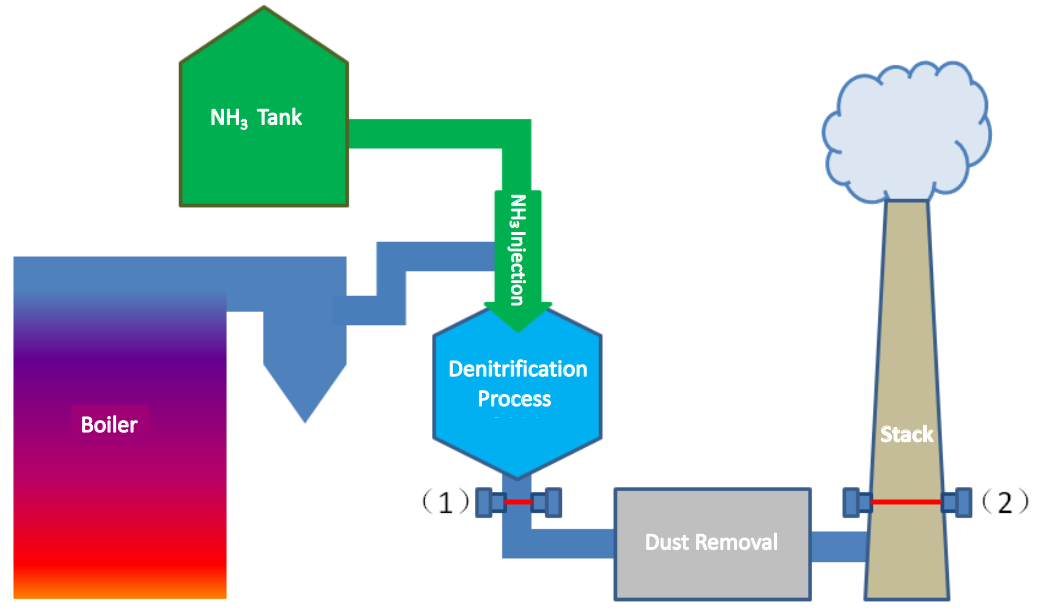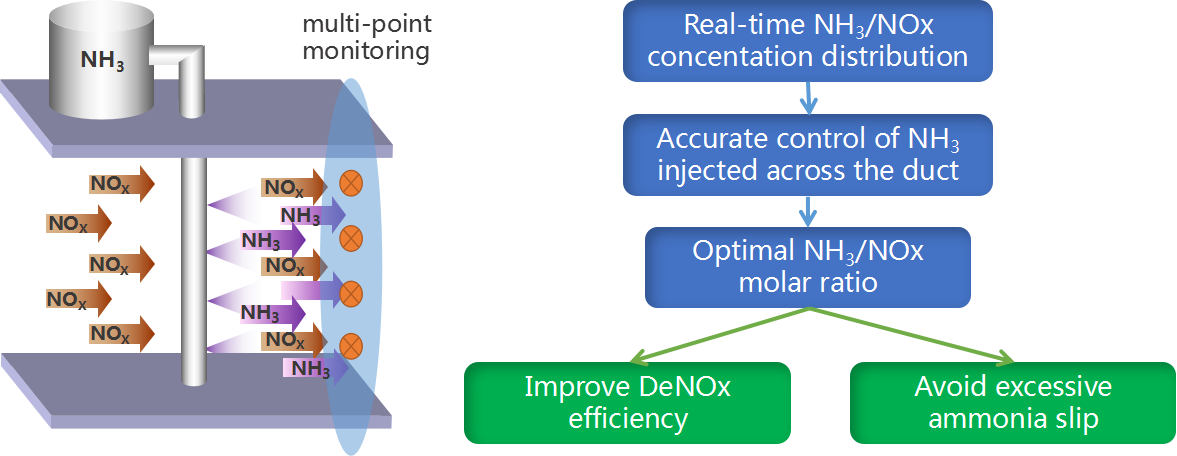 Home - Environmental monitoring - Applications - On-line ammonia escape detection for flue gas denitrification project in thermal power plant
Home - Environmental monitoring - Applications - On-line ammonia escape detection for flue gas denitrification project in thermal power plant
On-line ammonia escape detection for flue gas denitrification project in thermal power plant
The flue gas emitted from coal-fired boilers contains nitrogen oxides (NOx), a precursor to air pollution. Reducing NOx emissions is the focus of environmental regulations in most nations. Selective catalytic reduction (SCR) and selective non-catalytic reduction (SNCR) technologies are currently mainstream technologies for flue gas denitrification. Injected ammonia (NH3) reduces NOx to nitrogen (N2) and water (H2O), which are harmless to the environment.
In order to optimize the ammonia injection efficiency and reduce the NH3 emissions and consumption, the residual NH3 concentration (a.k.a. ammonia slip) in the flue gas must be monitored in real time. The ammonia slip monitor is generally installed at the end of the SCR/SNCR reduction reaction (1 below). It can also be installed at the final discharge of the flue (2 below) considering that ammonia is a harmful pollutant.

Hazards due to excessive ammonia slip
• Air preheater blocking due to Ammonia bi-sulfate (ABS) formation, which increases maintenance cost;
• Reliability issues caused by frequent flushing of air preheater;
• A shorter service life of the catalyst;
• Waste of ammonia;
• Air Pollution.
Problems in the traditional near-IR laser spectroscopy based ammonia slip monitors
• In-situ, cross-duct installation requires high precision for the flange opening. Vibration, expansion and contraction of
the duct affect the accuracy and the stability of the laser beam, leading to loss of signal;
• In-situ, cross-duct sensor systems cannot perform online calibrations;
• The near-IR absorption of ammonia spectrum at 1512nm is very weak, and the sensors are vulnerable to interference from the other gases;
• The resolution is low (lower detection limit is ~1ppmv);
• Single-point sampling and measurements do not represent the concentration distribution or the average of the entire flue cross-section.
Our solution: real-time NH3 (+NOx) accurate measurement + precise ammonia injection control

QCL+TDLAS technical advantages
HealthyPhoton adopts QCL+TDLAS technology, and the target spectrum is the absorption peak of ammonia molecules in the mid-IR region. Molecular spectroscopy studies have shown that the mid-IR absorption line of ammonia molecules is dozens of times stronger than that of near-IR. Under the same measurement conditions, the detection accuracy can reach ppb level, which is tens of times that of near-IR TDLAS. HealthyPhoton works with Princeton University as its patent authorizer and collaborator, and uses the world's leading semiconductor QCL as a laser source. Combining stable and reliable optomechanical design and exclusive signal processing technology, QCL-based TDLAS technology is able to achieve revolutionized precision and stability.
• Molecular spectral theory: The transition lines at the mid-IR fundamental band of the same molecule are much stronger than that of near-IR overtone band;
• Mid-IR measurement advantages:
1.Absorption intensity of ammonia molecules is about 100 times greater than the line peak at near-IR 1512nm;
2.The sensitivity is 100 times higher, fully satisfying the ammonia slip monitor market need;
Comparison of near-IR and mid-IR absorption line intensity of ammonia molecules
 Tel:+86-400 961 6990 Email:info@healthyphoton.com
Add:Room 305, Building 1, Zhongchuang Science Park, Jinyuan Road, Panhuo Street, Yinzhou District, Ningbo City,China
Tel:+86-400 961 6990 Email:info@healthyphoton.com
Add:Room 305, Building 1, Zhongchuang Science Park, Jinyuan Road, Panhuo Street, Yinzhou District, Ningbo City,China


